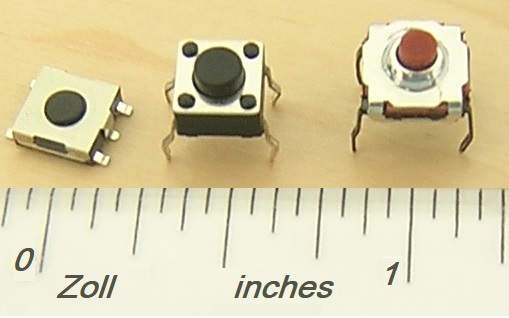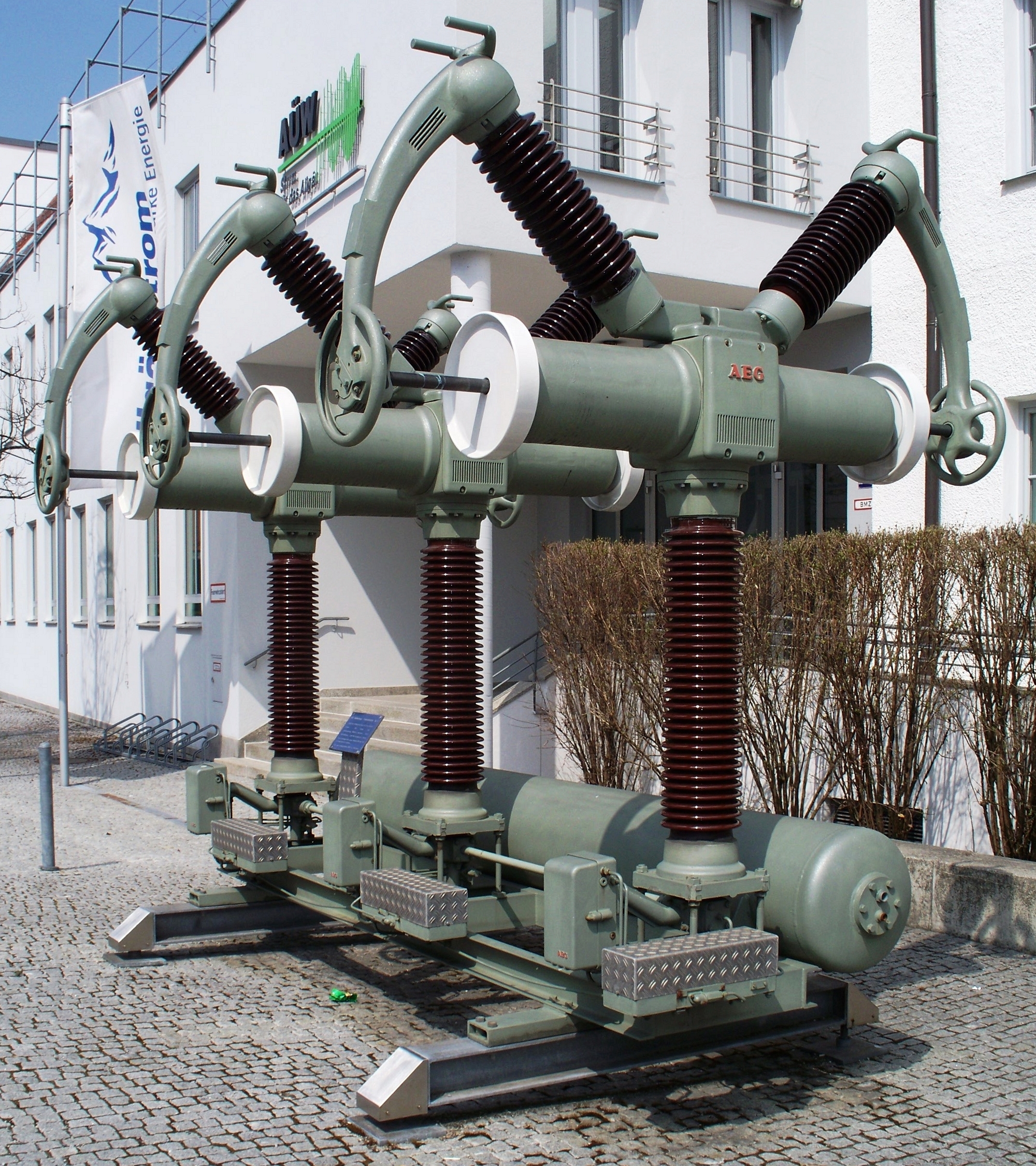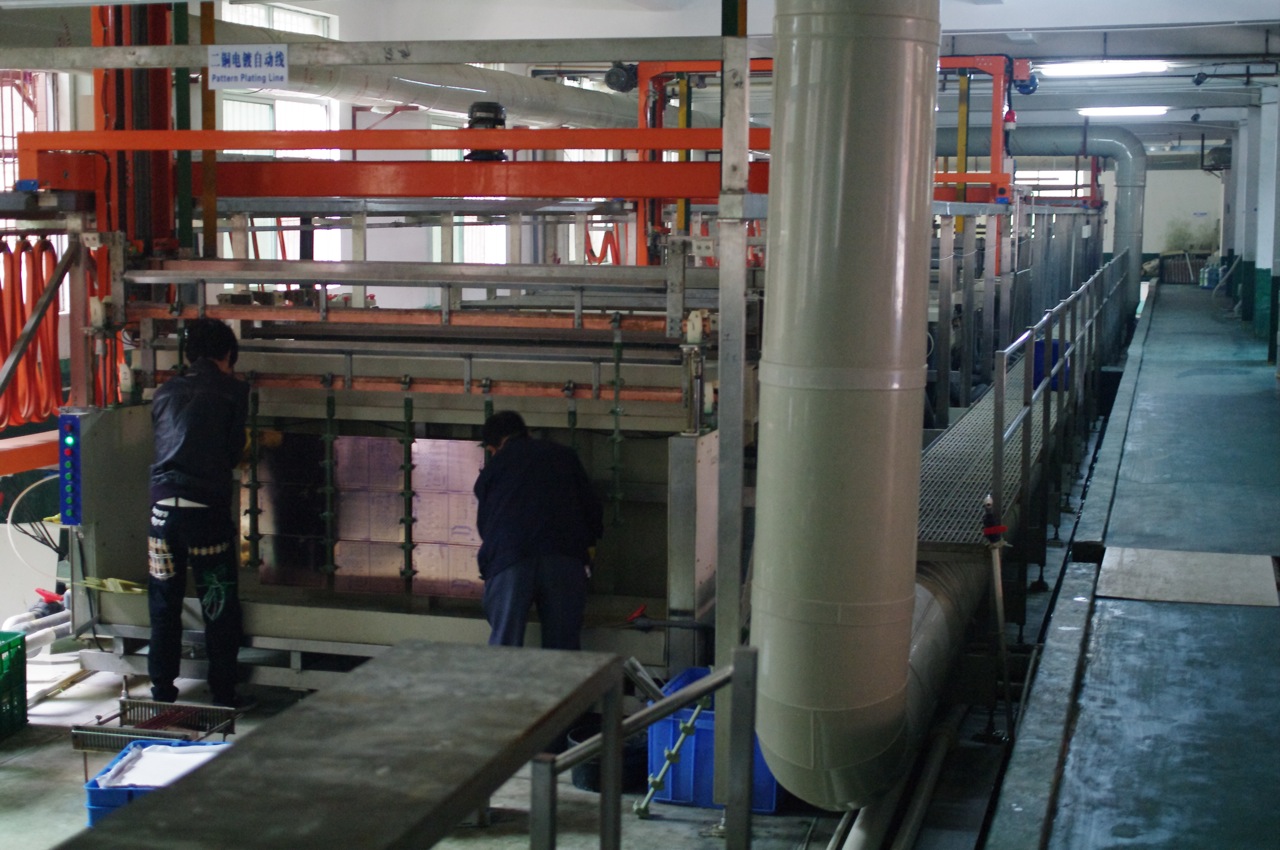|
Make-before-break
In electrical engineering, a switch is an electrical component that can disconnect or connect the conducting path in an electrical circuit, interrupting the electric current or diverting it from one conductor to another. The most common type of switch is an electromechanical device consisting of one or more sets of movable electrical contacts connected to external circuits. When a pair of contacts is touching current can pass between them, while when the contacts are separated no current can flow. Switches are made in many different configurations; they may have multiple sets of contacts controlled by the same knob or actuator, and the contacts may operate simultaneously, sequentially, or alternately. A switch may be operated manually, for example, a light switch or a keyboard button, or may function as a sensing element to sense the position of a machine part, liquid level, pressure, or temperature, such as a thermostat. Many specialized forms exist, such as the toggle switch ... [...More Info...] [...Related Items...] OR: [Wikipedia] [Google] [Baidu] |
Electrical Contacts
An electrical contact is an electrical circuit component found in electrical switches, relays, connectors and circuit breakers. Each contact is a piece of electrically conductive material, typically metal. When a pair of contacts touch, they can pass an electrical current with a certain contact resistance, dependent on surface structure, surface chemistry and contact time; when the pair is separated by an insulating gap, then the pair does not pass a current. When the contacts touch, the switch is ''closed''; when the contacts are separated, the switch is ''open''. The gap must be an insulating medium, such as air, vacuum, oil, SF6. Contacts may be operated by humans in push-buttons and switches, by mechanical pressure in sensors or machine cams, and electromechanically in relays. The surfaces where contacts touch are usually composed of metals such as silver or gold alloysMatsushita Electronics, "Relay Techninal Information: Definition of Relay Terminology", § Contact ... [...More Info...] [...Related Items...] OR: [Wikipedia] [Google] [Baidu] |
Rotary Switch
A rotary switch is a switch operated by rotation. These are often chosen when more than 2 positions are needed, such as a three-speed fan or a CB radio with multiple frequencies of reception or "channels". A rotary switch consists of a spindle or "rotor" that has a contact arm or "spoke" which projects from its surface like a cam. It has an array of terminals, arranged in a circle around the rotor, each of which serves as a contact for the "spoke" through which any one of a number of different electrical circuit An electrical network is an interconnection of electrical components (e.g., battery (electricity), batteries, resistors, inductors, capacitors, switches, transistors) or a model of such an interconnection, consisting of electrical elements (e. ...s can be connected to the rotor. The switch is layered to allow the use of multiple poles; each layer is equivalent to one pole. Alternatively the rotation can be limited to a fraction (half; third etc.) of a circle a ... [...More Info...] [...Related Items...] OR: [Wikipedia] [Google] [Baidu] |
Relay
A relay Electromechanical relay schematic showing a control coil, four pairs of normally open and one pair of normally closed contacts An automotive-style miniature relay with the dust cover taken off A relay is an electrically operated switch. It has a set of input terminals for one or more control signals, and a set of operating contact terminals. The switch may have any number of contacts in multiple contact forms, such as make contacts, break contacts, or combinations thereof. Relays are used to control a circuit by an independent low-power signal and to control several circuits by one signal. They were first used in long-distance telegraph circuits as signal repeaters that transmit a refreshed copy of the incoming signal onto another circuit. Relays were used extensively in telephone exchanges and early computers to perform logical operations. The traditional electromechanical relay uses an electromagnet to close or open the contacts, but relays using other operati ... [...More Info...] [...Related Items...] OR: [Wikipedia] [Google] [Baidu] |
Reversing Switch
In electrical engineering, a switch is an electrical component that can disconnect or connect the conducting path in an electrical circuit, interrupting the electric current or diverting it from one conductor to another. The most common type of switch is an electromechanical device consisting of one or more sets of movable electrical contacts connected to external circuits. When a pair of contacts is touching current can pass between them, while when the contacts are separated no current can flow. Switches are made in many different configurations; they may have multiple sets of contacts controlled by the same knob or actuator, and the contacts may operate simultaneously, sequentially, or alternately. A switch may be operated manually, for example, a light switch or a keyboard button, or may function as a sensing element to sense the position of a machine part, liquid level, pressure, or temperature, such as a thermostat. Many specialized forms exist, such as the toggle switc ... [...More Info...] [...Related Items...] OR: [Wikipedia] [Google] [Baidu] |
Electrical Contact
An electrical contact is an Electronic component, electrical circuit component found in electrical switches, relays, Electrical connector, connectors and circuit breakers. Each contact is a piece of electrically conductive material, typically metal. When a pair of contacts touch, they can pass an electrical current with a certain contact resistance, dependent on surface structure, surface chemistry and contact time; when the pair is separated by an insulator (electricity), insulating gap, then the pair does not pass a electric current, current. When the contacts touch, the switch is ''closed''; when the contacts are separated, the switch is ''open''. The gap must be an insulating medium, such as air, vacuum, oil, SF6, SF6. Contacts may be operated by humans in push-buttons and switches, by mechanical pressure in sensors or machine cams, and Electromechanics, electromechanically in relays. The surfaces where contacts touch are usually composed of metals such as silver or gold alloysM ... [...More Info...] [...Related Items...] OR: [Wikipedia] [Google] [Baidu] |
Noble Metal
A noble metal is ordinarily regarded as a metallic chemical element, element that is generally resistant to corrosion and is usually found in nature in its native element, raw form. Gold, platinum, and the other platinum group metals (ruthenium, rhodium, palladium, osmium, iridium) are most often so classified. Silver, copper, and Mercury (element), mercury are sometimes included as noble metals, but each of these usually occurs in nature combined with sulfur. In more specialized fields of study and applications the number of elements counted as noble metals can be smaller or larger. It is sometimes used for the three metals copper, silver, and gold which have filled D electron count, d-bands, while it is often used mainly for silver and gold when discussing surface-enhanced Raman spectroscopy involving metal nanoparticles. It is sometimes applied more broadly to any metallic or semimetallic element that does not react with a weak acid and give off hydrogen gas in the process. T ... [...More Info...] [...Related Items...] OR: [Wikipedia] [Google] [Baidu] |
Electroplating
Electroplating, also known as electrochemical deposition or electrodeposition, is a process for producing a metal coating on a solid substrate through the redox, reduction of cations of that metal by means of a direct current, direct electric current. The part to be coated acts as the cathode (negative electrode) of an electrolytic cell; the electrolyte is a solution (chemistry), solution of a salt (chemistry), salt whose cation is the metal to be coated, and the anode (positive electrode) is usually either a block of that metal, or of some inert electrical conductor, conductive material. The current is provided by an external power supply. Electroplating is widely used in industry and decorative arts to improve the surface qualities of objects—such as resistance to abrasion (mechanical), abrasion and corrosion, lubrication, lubricity, reflectivity, electrical conductivity, or appearance. It is used to build up thickness on undersized or worn-out parts and to manufacture metal ... [...More Info...] [...Related Items...] OR: [Wikipedia] [Google] [Baidu] |
Wetting Current
In electrical and electronics engineering, wetting current is the minimum electric current needing to flow through a contact to break through the surface film resistance at a contact. It is typically far below the contact's nominal maximum current rating. A thin film of oxidation, or an otherwise passivated layer, tends to form in most environments, particularly those with high humidity, and, along with surface roughness, contributes to the contact resistance at an interface. Providing a sufficient amount of wetting current is a crucial step in designing Electrical circuit, circuits that use switches with low contact pressure. Failing to do this might result in switches remaining electrically "open" when pressed, due to contact oxidation. Capacitor discharge solution In some low voltage applications, where switching current is below the manufacturer's wetting current specification, a capacitor discharge method may be employed by placing a small capacitor across the switch contac ... [...More Info...] [...Related Items...] OR: [Wikipedia] [Google] [Baidu] |
Contact Resistance
Electrical contact resistance (ECR, or simply contact resistance) is resistance to the flow of electric current caused by incomplete contact of the surfaces through which the current is flowing, and by films or oxide layers on the contacting surfaces. It occurs at electrical connections such as switches, connectors, breakers, contacts, and measurement probes. Contact resistance values are typically small (in the microohm to milliohm range). Contact resistance can cause significant voltage drops and heating in circuits with high current. Because contact resistance adds to the intrinsic resistance of the conductors, it can cause significant measurement errors when exact resistance values are needed. Contact resistance may vary with temperature. It may also vary with time (most often decreasing) in a process known as resistance creep. Electrical contact resistance is also called ''interface resistance'', ''transitional resistance'', or the ''correction term''. ''Parasitic resist ... [...More Info...] [...Related Items...] OR: [Wikipedia] [Google] [Baidu] |
Electrical Conductivity
Electrical resistivity (also called volume resistivity or specific electrical resistance) is a fundamental specific property of a material that measures its electrical resistance or how strongly it resists electric current. A low resistivity indicates a material that readily allows electric current. Resistivity is commonly represented by the Greek alphabet, Greek letter (Rho (letter), rho). The SI unit of electrical resistivity is the ohm-metre (Ω⋅m). For example, if a solid cube of material has sheet contacts on two opposite faces, and the Electrical resistance, resistance between these contacts is , then the resistivity of the material is . Electrical conductivity (or specific conductance) is the reciprocal of electrical resistivity. It represents a material's ability to conduct electric current. It is commonly signified by the Greek letter (Sigma (letter), sigma), but (kappa) (especially in electrical engineering) and (gamma) are sometimes used. ... [...More Info...] [...Related Items...] OR: [Wikipedia] [Google] [Baidu] |








